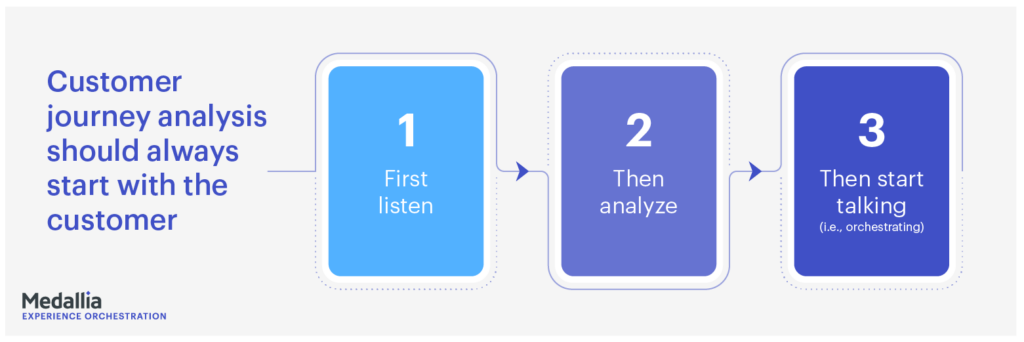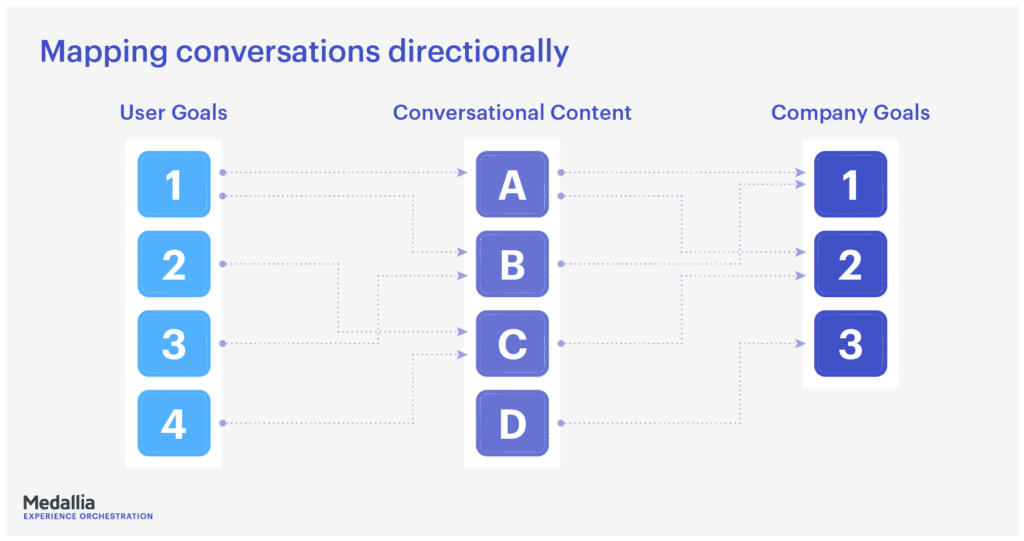The Modern Approach to Customer Journey Analysis
July 23, 2024
Customer Experience
Thanks to customer journey orchestration, our understanding and management of customer journeys has improved significantly. As related analysis platforms have developed, brands have increasingly sought to capitalize on customer journey analytics. Here’s what you need for effective customer journey analysis.
Customer journeys are the customer interactions made across brand touchpoints, such as app, website, or in-store interactions. These journeys depict what customers are actually doing, as opposed to what a brand organization thinks they are doing. Customer Journey Analysis monitors the impacts of every two-way engagement between a brand and its customers, across the entire customer lifecycle. In essence, customer journey analytics explore tangible customer behavior, and provide data-driven insights to better understand how that behavior impacts business outcomes.
Benefits of Customer Journey Analysis
Understanding customers’ needs and intentions significantly benefits a brand. There are several advantages to using customer journey analysis. Here are the most relevant ones:
Enhance the Customer Experience
By analyzing customer journeys, brands can identify areas where the customer experience is lacking and take steps to improve it. This could be anything from streamlining processes to changing a product or service based on customer feedback.
Identify Opportunities
Customer journey analysis can reveal patterns of behavior, such as when customers are interested in particular products, services, or features. Brands can leverage this data to identify opportunities for cross-selling, upselling, or improving their offerings.
Uncover Gaps in Service
Not only can customer journey analysis identify pain points, but it can also uncover gaps in service. By analyzing customer journeys, brands can see where customers are dropping off or experiencing issues and take action to address these gaps.
Increases Conversion Rates
Understanding customer journeys can also lead to increased conversion rates. By analyzing the paths customers take before making a purchase, brands can optimize their marketing, sales, and omnichannel experiences strategies accordingly.
Making journey analysis work for business
The secret to an effective analysis lies in a clear hypothesis and a balanced approach towards long-term strategies and day-to-day tasks. It is essential to start with a key question or assumption to avoid unnecessary pressures on resources and budgets without obtaining useful insights.
Avoid allowing your analysis to become overly theoretical or insufficiently strategic by ensuring alignment between overarching strategies and daily operations. Successful analysis requires the ability to flip between detailed daily scrutiny and strategic long-term perspective. Neglecting either aspect can lead to unproductive outcomes, whereas a balanced approach ensures a comprehensive understanding of the customer journey, leading to tangible benefits for the business.
Getting started with Customer Journey Analysis: An engagement strategy with goals
As a leading technology player in journey analytics, we help to articulate a specific overarching customer strategy and goals for the business upfront. This will be a pivotal area of focus for journey analysis, generally requiring us to consider why customers choose the brand and what they’re seeking.
- Tip one: The strategies often define why the brand exists, and what it’s there to do for its customers. The goals are more tactical things the business wants to achieve within those strategies.
- Tip two: Always think from the customer’s own perspective.
Here are some real examples of overarching engagement strategies and related goals that brands have shared with us over the years:
Telecommunications (Telco)
Strategy: Increase revenue
- Company Goal: Sell more bundled packages to increase ARPU
- Customer Goal: Acquire the lowest cost plan for desired services
Pharma and Healthcare
Strategy: Increase engagement
- Company Goal: Ensure accurate and current drug information is available, communicated and supportive of health care providers
- Health Care Provider Goal: Have accurate and current drug information to best advise and care for patients
Retail Banking
Strategy: Increase revenue
- Company Goal: Increase household “share of wallet”
- Customer Goal: Get the best rate of return, reduced fees, added incentives and ease of access across my accounts
Sports
Strategy: Increase engagement
- Company/Team Goal: Understand each fan’s favorite player and promote that player wherever possible to that fan
- Customer/Fan Goal: Follow their favorite player and receive the latest highlights and offers about that player
Notice the differences between brand and customer perspectives; sometimes subtle, other times more blatant. And while the result is common (something is purchased, or information is shared), the rationale and motivations are typically different. For brands that are serious about being customer-centric, there is an urgent need to articulate and embrace why customers arrive – and stay.
Buying into the concept of customer-centricity doesn’t prevent us from mapping these motivations or experiences directly to internal revenue or cost targets. The mere act of aligning financial needs within customers’ needs can begin to shift the organizational mindset – and of course, we know that profit and growth are driven by customer engagement.
Identifying conversations and listening to customer behavior
Conversations are the means through which we can use journey analysis to show improvements in customer engagement. Confident in our fundamental engagement strategy and goal, we can contemplate how to positively impact customer journeys. This exercise should directly support the strategy and related perspectives.
While journey orchestration allows us to engage in new ways (that are more informed, relevant, real time, and consistent), we still need to determine what we want to say, to whom, where, and when. Every opportunity for a more relevant customer conversation is appraised by how it can positively impact a customer’s journey outcomes and experiences with our brand. Once we’ve identified the types of conversations we could have, it’s possible to begin listening to customer behavior.
Approach: Plan Big, Start Small
Our approach is to plan big and start small. In the earlier Telco example, while the organization could capture every possible interaction, they managed to maintain focus by selecting just two of these channels to start.
Customer Journey Analysis and Conversations
In customer journey analysis, conversations are the means through which we can show journey improvement. As an evolving connection between brands and their customers, they provide crucial customer feedback, allowing us to analyze behavior before and after each interaction takes place.
Analyzing Impact in the Telco Scenario
In the Telco scenario, the business analyzed which conversations had the highest rate of increase in the number of successful bundle purchases, as compared to before the conversation occurred. The variables (information, channel, delivery method, timing) became highly significant when considering key influences in the customer’s experience.
Tracking customer journey progress
Once the conversations have been running for a bit (we usually recommend at least one business week to start, two weeks if possible), we can perform journey analysis comparing specific customer journey behavior before and after each conversation and measure the holistic impact on our strategy.
Unlike the analysis of traditional journey maps, an important element to understanding end-to-end customer journeys is our ability to digest the impact of experiences over time. Ultimately, journey orchestration seeks to provide an engagement layer that unifies all conversations, across every customer facing system – and Customer Journey Analysis helps us make sense of it all.
Top tools for Customer Journey Analysis
Customer Journey Analytics
Drive improvements across critical customer journey touchpoints with AI-powered analysis of every interaction across the customer journey.
Digital Customer Journey Analytics
Easily score the quality of your digital customer experiences across your company’s websites and apps with digital customer journey analytics and digital journey visualization tools that help teams assess the factors that affect customer navigation, frustration, and conversions. These solutions offer funnels for tracking dropoff, digital experience scores for every customer journey, and forensic features like heatmaps and session replay that walk you through your users’ unique journeys.
Customer Journey Market Research Insights
Market research insights can shed light on what matters most for the customer journey, and can be particularly helpful for gathering learnings when companies roll out new innovations and improvements
Customer Journey Orchestration
With a customer journey orchestration solution, brands can move from customer journey analysis to action, using real-time insights to deliver the next best experience for customers at the individual level based on their dynamic behavior and needs.
Digital Customer Journey Analytics and Behavioral Analytics Tools
By understanding how customers interact with a company’s digital platforms and products or services, businesses can make data-driven decisions to improve user experiences and drive engagement.
Customer Journeys Analysis: Keep It Simple
When it comes to customer journey analysis, simplicity is key. It’s essential to have a clear understanding of your objectives and start small by focusing on specific channels or touchpoints. By using the right tools and aligning your analysis with your overall business strategy, you can gain valuable insights into customer behavior and make data-driven decisions that drive success for your brand.
Looking for solutions to enhance your customer journey analysis? Speak with a Medallia Expert to learn about our suite of customer journey solutions, including our customer journey analytics, digital customer journey and journey visualization tools, customer journey orchestration solution, and customer journey market research insights offerings.







